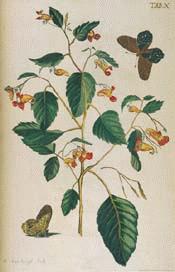

|
Common Jujube
(Ziziphus jujuba Mill.)
|
Jujube Berries
Botanical: Zizyphus vulgaris (LAMK.)
Family: N.O. Rhamnaceae
---Synonyms---Zizyphus sativa. Brustbeeren. Judendornbeeren. Rhamnus Zizyphus.
---Part Used---Fruit.
---Habitat---Southern Europe.
---Habitat---Originally a native of Syria, Zizyphus vulgaris was introduced into Italy in the reign of Augustus, and is now naturalized in Provence, and particularly in the islands of HyŠres, where the berries are largely collected when ripe, and dried in the sun.
The trees average 25 feet in height and are covered with a rough, brown bark. They have many branches, with annual thorny branchlets bearing alternate, oval-oblong leaves of a clear green colour, with three to five strongly-marked, longitudinous veins. The small flowers are pale yellow and solitary. The fruit is a blood-red drupe, the size and shape of an olive, sweet, and mucilaginous in taste, slightly astringent. The pulp becomes softer and sweeter in drying, and the taste more like wine. They have pointed, oblong stones.
---Constituents---A full analysis has not yet been made, but the berries are valued for their mucilage and sugar.
---Medicinal Action and Uses---The Jujube is classed with the raisin, date, and fig as a pectoral fruit, being nutritive and demulcent. It is eaten both fresh and dried.
A syrup and a tisane were formerly made from it, but the berries are now little used in medicine.
Jujube paste, or 'Pâte de Jujubes,' is made of gum-arabic and sugar. It may be dissolved in a decoction of jujubes and evaporated, but is considered as good a demulcentwithout their addition. It is frequently merely mixed with orange-flower water.
A decoction of the roots has been used in fevers.
An astringent decoction of leaves and branchlets is made in large quantities in Algeria, and seems likely to replace the cachou.
[Top]
---Other Species---
Z. Lotos, sometimes also called Z. sativa, of Northern Africa and Z. Jujuba of the East Indies possess similar properties, and are used in their respective countries. Z. Lotos is thought to have been one of the sources of the famous sweet fruits from which the ancient Lotophagi took their name, the liqueur prepared from which caused those who partook of it to forget even their native countries in its enjoyment. The Arabs call it Seedra. In Arabia a kind of bread is made of them by exposing them to the sun for a few days and then pounding them in a wooden mortar to separate the stones. The meal is mixed with water and formed into cakes which after drying in the sun resemble sweet gingerbread.
Z. Baclei is said to be used in the same way in Africa, and also for making a beverage.
Z. Jujuba is largely cultivated by the Chinese, in many varieties as a dessert fruit, some being called Chinese Dates, and it is also one of the main sources of stick-lac.
Z. Cenoplia of India has edible fruits, and the bark is esteemed as a vulnerary.
In Cochin-China the berries of Z. agrestis are eaten.
In Senegal the fruits of Z. Barelei are slightly styptic, and the negroes use the roots for gonorrhoea. It is probably the same species that is used there in venereal diseases.
A decoction of the dried leaves of Z. Napeca is said to be used for washing ulcers in Arabia.
Z. spina Christi, or Rhamnus spina Christi, of Ethiopia, is said to be the source of the crown of thorns placed on the Saviour's head. The Arabs call it Nabka.
[Top]
Common Name Index
A MODERN HERBAL Home Page
Bear in mind "A Modern Herbal" was written with the conventional wisdom of the early 1900's. This should be taken into account as some of the information may now be considered inaccurate, or not in accordance with modern medicine.
© Copyright Protected 1995-2004 botanical.com

| 
